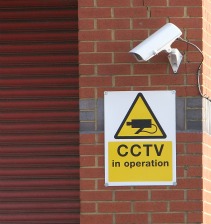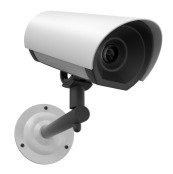"Is a CCTV Security System for You?"
A CCTV security system is a viable home surveillance option for many homeowners. Another home surveillance option is IP Video Surveillance. This section deals with CCTV (Closed-Circuit Television) analog surveillance.

What is CCTV?
A CCTV security system uses analog systems to transmit images from the camera to a monitoring location. The monitoring location is usually within the same building or residence. A CCTV system is a closed system, as opposed to broadcast television which is openly transmitted.
Advantages of CCTV
Lower Cost
An advantage of a CCTV security system is that it generally has a lower cost than IP/Digital surveillance systems. Since surveillance should be one aspect of your home security strategy, having a viable and economical option in CCTV can ensure that you have a complete system.
Better for Low Light
A CCTV camera also has been shown to better handle lower lighting conditions than IP systems do. If you have surveillance in a darker room, the CCTV camera will be able to pick up the images better.
Adaptability
Also, a CCTV security system will be able to handle different types and matches between cameras and surveillance hardware.
You also have the option of converting your analog signals from the cameras to a digital recorder. This will allow you to find footage very easily.
Disadvantages of CCTV
Features
CCTV technology has been around for decades. The latest technical advances has come in IP security systems. For this reason, the quality of features is not as great as IP.
Cabling
The cabling for CCTV systems is more expensive. If you have a larger residence, the cabling and complexity of installation can cause you to think twice about purchasing this system.
What's in a CCTV System?
There are a few main components to a CCTV security system.
Camera
The camera is one of the main aspects of a CCTV system. There are many different types of cameras with many options available to you.
Monitor
A monitor is needed to view the images from the camera. The monitor is usually in one central location close to where the surveillance is occurring. The resolution on the monitors is higher than a TV's. A monitor can display images from one camera (dedicated) or can display images from multiple cameras (call-up).
Cables
Coaxial cables are used to connect the devices within a CCTV security system. The cables are relatively expensive. They also can be difficult to install if the cameras are in hard-to-reach locations.
DVR Recorders
A DVR (Digital Video Recorder)increasingly is being used within CCTV systems. The DVR converts the analog footage to digital. This allows operators to easily find footage from a certain time or day.
CCTV Camera Types
The two main classifications of CCTV cameras are Fixed cameras and PTZ cameras.
Fixed Cameras
As the name suggests, fixed cameras view a specific location. They are usually visible and also serve to deter criminals.
PTZ Cameras
A PTZ (pan, tilt,zoom)camera's viewing angle can be changed and adjusted remotely. Operators can zoom, tilt, and pan to get to optimal monitoring. With CCTV PTZ cameras, additional cables are needed for the cameras to perform the different functions. So, this adds to the cost and complexity of the surveillance system.
CCTV Image quality

CCTV Image quality is measured in the form of a TVL (TV Lines). The amount of detail that you can measure in three quarters of the picture width will determine the horizontal TVL. Most standard CCTV cameras provide a 380 TVL resolution. Better resolution cameras can go up to 540 TVL.
There are some great benefits to using a digital video recorder to record video. The analog system from CCTV can be converted to digital. But there is a slight loss in image quality when this is completed. It is harder to remain image quality because of the various conversions of analog to digital from the camera to the recorder.
Different options to Convert Analog to Digital
There are several options when converting the analog signals from a CCTV system to a digital signal.
Video Encorders
Video encorders convert analog video signals so they can be sent over the Internet. This will allow you to view surveillance video feeds on devices that are connected to the Internet, such as computers or cell phones.
Hybrid DVR's
Hybrid DVR's are another option when converting analog signals. This type of DVR can handle both analog signals from CCTV cameras and digital signals from IP cameras. This is useful because you are not limited to using one type of camera within your surveillance system.



